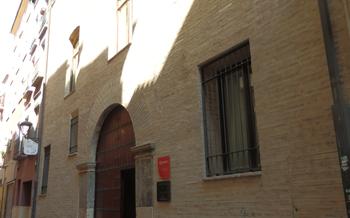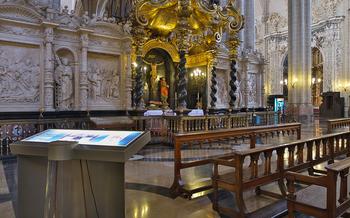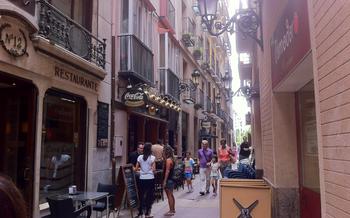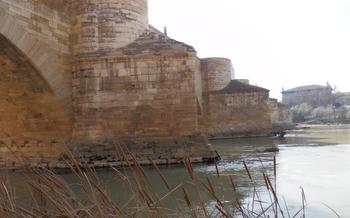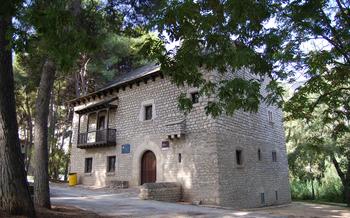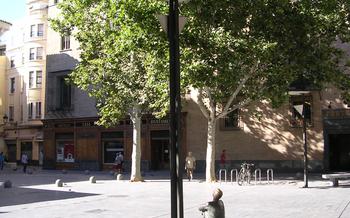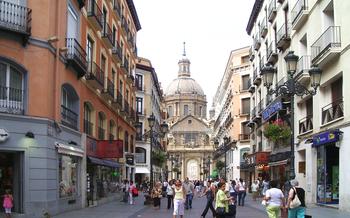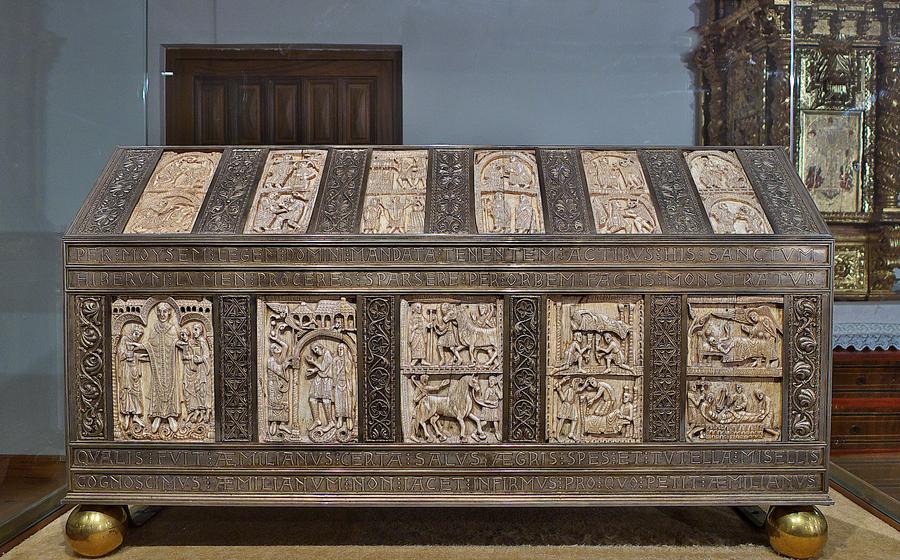
Casa de la Mujer
- Casa de la Mujer
- La Seo Cathedral
- Aljafería Palace
- Plaza del Pilar
- El Tubo District
- Goya Museum
- Museum of Zaragoza
- Pablo Gargallo Museum
- Gran Vía
- Parque del Agua Luis Buñuel
- Monasterio de Piedra
- Loarre Castle
- Fuendetodos: The Birthplace of a Master
- Insider Tip
Casa de la Mujer
The Casa de la Mujer, or "House of Women," is a historic building located in the heart of Zaragoza, Spain. Originally constructed in the 16th century as a palace for the Count of Monreal, the building has a rich history and has served various purposes over the years.
Architectural Features
The Casa de la Mujer features a blend of Renaissance and Gothic architectural styles, showcasing intricate facades, arched windows, and a grand courtyard. Its elegant exterior is adorned with sculptures and carvings that depict mythological figures and scenes from history, adding to its artistic and cultural significance.
Current Use of the Building
Today, the Casa de la Mujer serves as a cultural center dedicated to promoting women's rights and gender equality. It houses various organizations and initiatives aimed at empowering women, providing support, and raising awareness about gender-related issues. The center also hosts events, workshops, and exhibitions related to women's rights and history.
Cultural Significance
The Casa de la Mujer holds significant cultural value as it represents the ongoing struggle for women's rights and empowerment in Spain. It serves as a symbol of progress, resilience, and the fight for gender equality, making it an important landmark in Zaragoza's cultural landscape.
La Seo Cathedral
The La Seo Cathedral, also known as the Cathedral of Saint Savior, is a masterpiece of Gothic architecture, showcasing intricate details and awe-inspiring grandeur. Its construction began in the 12th century and spanned several centuries, resulting in a harmonious blend of architectural styles. The exterior boasts an impressive facade adorned with elaborate carvings, soaring towers, and delicate tracery that reach for the sky.
The interior of the cathedral is equally breathtaking, with its soaring ribbed vaults and stained-glass windows casting a kaleidoscope of colors onto the marble floors. One of the highlights is the collection of tapestries, which depict biblical scenes and historical events with intricate detail and vibrant hues. The alabaster altarpiece, known as the Retablo Mayor, is another remarkable sight, showcasing intricate carvings and sculptures that narrate the life of Jesus Christ.
Additionally, the Mudejar tower, a remnant of the city's Islamic past, stands tall as a testament to Zaragoza's rich cultural heritage. Its unique blend of Moorish and Christian elements, including intricate brickwork and ceramic tiles, creates a fascinating contrast to the Gothic grandeur of the cathedral.
Aljafería Palace
The Aljafería Palace is a stunning example of Moorish architecture, showcasing the rich cultural heritage of Zaragoza. Built in the 11th century, the palace served as the residence of the Banu Hud dynasty, the Muslim rulers of Zaragoza. Its intricate carvings, delicate arches, and vibrant tilework transport visitors back to a time of grandeur and artistry.
One of the highlights of the palace is the throne room, with its magnificent dome and exquisite decorations. The room's intricate plasterwork and colorful tiles create an awe-inspiring atmosphere, evoking the opulence and power of the former rulers.
The palace's restored gardens are another must-see, offering a tranquil oasis amidst the bustling city. Stroll through the lush gardens, admire the vibrant flowers, and soak in the serene atmosphere, as you imagine the royal court enjoying this beautiful space centuries ago.
The historical significance of the Aljafería Palace cannot be overstated. It played a pivotal role in the history of Zaragoza, serving as a royal residence, a military fortress, and even a prison during the Spanish Inquisition. Today, it stands as a testament to the city's rich past and serves as a symbol of its cultural diversity.
Plaza del Pilar
The dazzling Plaza del Pilar is the lively heart of Zaragoza, brimming with architectural wonders and vibrant energy. This sprawling square derives its name from the awe-inspiring Basílica de Nuestra Señora del Pilar, a monumental Baroque masterpiece that dominates the cityscape with its soaring spires and intricate façade.
The grand town hall, with its elegant Renaissance architecture, stands proudly adjacent to the basilica, adding to the square's architectural splendor. Its intricate details and historical significance make it a captivating sight.
In the center of the plaza, the eye is drawn to the Fuente de la Hispanidad, an impressive fountain adorned with sculptures symbolizing the unity of the Spanish-speaking world. Its cascading waters create a soothing ambiance, inviting visitors to linger and soak in the beauty of their surroundings.
Surrounding the plaza, a plethora of shops, cafés, and restaurants offer a delightful array of culinary experiences and shopping opportunities. Whether you seek traditional Aragonese cuisine or international flavors, the Plaza del Pilar has something to satisfy every palate.
El Tubo District
In the heart of Zaragoza, nestled among the narrow, winding streets of the old city, lies El Tubo District, a vibrant neighborhood renowned for its lively atmosphere and culinary delights. Step into this charming district, and you'll be greeted by a labyrinth of cobblestone streets, where history and gastronomy intertwine.
El Tubo, meaning "the pipe" in Spanish, derives its name from the ancient Roman aqueduct that once ran beneath its streets. Today, this historic quarter has transformed into a culinary haven, boasting a plethora of tapas bars, traditional restaurants, and trendy cafés.
As you wander through El Tubo, the tantalizing aromas of freshly prepared tapas will entice you into one of the many small bars lining the streets. Here, you can indulge in a culinary journey, sampling a variety of traditional Spanish dishes in bite-sized portions. From patatas bravas, topped with a spicy tomato sauce, to croquetas, filled with creamy béchamel and ham, the choices are endless.
In addition to its culinary delights, El Tubo exudes a vibrant energy, especially during the evening hours. As the sun sets, the district comes alive with locals and visitors alike, filling the streets with laughter, conversation, and the clinking of glasses.
Strolling through El Tubo, you'll also encounter charming boutiques, art galleries, and specialty shops, offering a unique blend of shopping and cultural experiences. Whether you're looking for handmade souvenirs, local artwork, or simply a leisurely stroll, El Tubo has something to offer everyone.
Goya Museum
The Goya Museum is a must-see for any art lover visiting Zaragoza. The museum houses a vast collection of works by Francisco de Goya, one of Spain's most celebrated artists. Visitors can admire Goya's paintings, engravings, and drawings, which offer a fascinating insight into his life and work.
The museum is located in the Palacio de los Condes de Sástago, a beautiful 16th-century building in the heart of Zaragoza. The museum's collection is housed in 11 exhibition rooms, which are arranged chronologically. Visitors can follow Goya's artistic development from his early years as a court painter to his later, more experimental works.
Some of the highlights of the collection include the paintings "The Third of May 1808" and "Saturn Devouring His Son," both of which are considered masterpieces of Spanish art. The museum also has a large collection of Goya's engravings, which offer a unique perspective on his artistic process.
In addition to Goya's works, the museum also houses a collection of works by other Spanish artists, including El Greco, Velázquez, and Zurbarán. The museum also has a library and a research center, which are open to the public.
Museum of Zaragoza
The Museum of Zaragoza, located in the heart of the city, is a treasure trove of art and history, offering visitors a glimpse into the rich cultural heritage of the region. Founded in 1868, the museum houses a diverse collection of artifacts, spanning from ancient Roman times to the present day.
Roman Artifacts
The museum's Roman collection is particularly noteworthy, showcasing a range of artifacts that shed light on the region's Roman past. Visitors can admire intricate mosaics, elegant sculptures, and well-preserved ceramics, all providing insights into the daily lives and artistic traditions of the Roman inhabitants of Zaragoza.
Medieval Art
The museum also boasts an impressive collection of medieval art, including stunning examples of Romanesque and Gothic sculpture, as well as intricate gold and silverwork. Visitors can marvel at the delicate craftsmanship and religious iconography that characterize these medieval masterpieces.
Fine Art
The museum's fine art collection features works by renowned Spanish artists from the Renaissance to the modern era. Among the highlights are paintings by Francisco de Goya, one of Spain's most celebrated artists, as well as works by other notable artists such as El Greco, Jusepe de Ribera, and Pablo Gargallo.
Ethnographic Exhibits
In addition to its art collection, the Museum of Zaragoza also houses a fascinating collection of ethnographic exhibits, showcasing the traditional customs and lifestyles of the people of Aragon. Visitors can learn about local crafts, costumes, and traditions, gaining a deeper understanding of the region's cultural identity.
Pablo Gargallo Museum
The Pablo Gargallo Museum is's collection includes over 200 works by Gargallo, including sculptures, drawings, and engravings. The collection spans the artist's entire career, from his early figurative works to his later abstract works.
Some of the highlights of the collection include the sculptures "The Prophet" (1908), "The Dancer" (1912), and "The Head of a Woman" (1933). The museum also has a collection of Gargallo's drawings and engravings, which provide insight into his creative process.
In addition to the permanent collection, the museum also hosts temporary exhibitions of Gargallo's work and the work of other artists. The museum also offers a variety of educational programs and workshops.
The Pablo Gargallo Museum is a must-see for anyone interested in the work of this important sculptor. The museum's collection provides a comprehensive overview of Gargallo's career, and the museum's temporary exhibitions and educational programs offer visitors a deeper understanding of his work and its significance.
Gran Vía
The Gran Vía is one of the most vibrant and lively streets in Zaragoza. It is a long, wide boulevard that is lined with shops, restaurants, and cafés and buzzes with activity both day and night, with street performers and tourists enjoying this lively artery of the city.
The Gran Vía is also a great place to go shopping, offering everything from souvenirs and local products to designer clothes. If you are looking for a place to relax and enjoy a meal, the Gran Vía has plenty of options, from tapas bars to fine dining restaurants. In the evening, the street transforms into a vibrant nightlife hub, with bars and clubs staying open until the early hours of the morning. It is a great place to experience the city's vibrant atmosphere and meet new people.
Parque del Agua Luis Buñuel
The green oasis of Zaragoza
Escape the hustle and bustle of the city at Parque del Agua Luis Buñuel, is a haven of tranquility and a popular spot for locals and tourists alike to relax and unwind.
Stroll along the tranquil lake, surrounded by lush gardens and towering trees, and admire the colorful array of flowers that bloom throughout the year. Let the kids run free in the playgrounds, complete with slides, swings, and climbing frames, while you soak up the sun on the grassy banks.
For the more adventurous, there are plenty of water sports to try, including kayaking, canoeing, and paddleboarding. Take a leisurely boat ride on the lake to admire the park from a different perspective, or simply relax and enjoy a picnic with friends and family.
Parque del Agua Luis Buñuel is more than just a park; it's a cultural and educational center. The park hosts a variety of events and exhibitions throughout the year, from concerts and art shows to educational workshops and nature walks. There's also a museum dedicated to the history and culture of the Ebro River, where you can learn about the importance of this vital waterway to the region.
Whether you're looking for a place to relax and rejuvenate, or an exciting day out with the family, Parque del Agua Luis Buñuel is the perfect destination. So come and explore this urban oasis, and discover a hidden gem in the heart of Zaragoza.
Monasterio de Piedra
The Monasterio de Piedra is a former Cistercian monastery located in the town of Nuévalos, in the province of Zaragoza, Spain. It is situated in a natural park with the same name, which is known for its beautiful scenery, including a lake, waterfalls, and rock formations. The monastery was founded in 1194 by King Alfonso II of Aragon and was an important religious center until the 19th century when it was abandoned. In 1983, the monastery was declared a National Monument and has since been restored and opened to the public.
The Monasterio de Piedra is a beautiful example of Romanesque architecture and features a number of interesting features, including a cloister, a chapter house, and a refectory. The monastery is also home to a number of works of art, including paintings, sculptures, and tapestries. The surrounding natural park offers a variety of activities for visitors, including hiking, biking, and fishing.
Insider Tip: Be sure to visit the monastery's gardens, which are home to a variety of plants and flowers. The gardens are a great place to relax and enjoy the scenery.
Loarre Castle
Loarre Castle, a magnificent example of Romanesque architecture, stands majestically atop a rocky hill, offering breathtaking views of the surrounding countryside. Its construction began in the 11th century and continued for over a century, resulting in an impressive fortress that served as a strategic defensive point and a residence for the local lords.
The castle's exterior features imposing walls, fortified towers, and a grand entrance gate. The interior reveals a fascinating glimpse into medieval life, with its well-preserved rooms, including the throne room, the chapel, and the living quarters. Visitors can explore the castle's many levels, discovering secret passages, hidden chambers, and stunning panoramic views from the towers.
Loarre Castle has played a significant role in Spanish history, having witnessed battles, sieges, and royal visits throughout the centuries. Its strategic location made it a key defensive point during the Reconquista, and it was also a favorite residence of the Aragonese kings. Today, the castle stands as a testament to the region's rich history and cultural heritage.
Visitors to Loarre Castle can take guided tours to learn about its history and explore its many fascinating features. The castle is open to the public year-round, and admission fees are reasonable. Whether you're a history buff, an architecture enthusiast, or simply looking for a unique and memorable experience, Loarre Castle is an absolute must-see.
Fuendetodos: The Birthplace of a Master
Journey to the picturesque village of Fuendetodos, nestled amidst the rolling hills of Aragon, to discover the birthplace of the legendary artist Francisco de Goya. Immerse yourself in the vibrant culture and history that shaped Goya's early life as you explore the streets and landmarks that inspired his artistic genius.
At the heart of the village, visit the Goya Museum, housed in the very building where Goya was born in 174Delve into the artist's formative years through a collection of his early works, personal belongings, and fascinating insights into his life and creative process.
Stroll through the charming Plaza Mayor, the main square of Fuendetodos, and admire the 17th-century Town Hall, a testament to the village's rich architectural heritage. In the surrounding streets, discover historic buildings and landmarks that have remained virtually unchanged since Goya's time, offering a glimpse into the world that shaped his artistic sensibilities.
Don't miss the opportunity to visit the Church of Nuestra Señora de la Asunción, where Goya was baptized and where his parents are buried. The church's interior boasts beautiful frescoes and religious artworks, providing a glimpse into the religious and cultural traditions that influenced Goya's upbringing.
As you wander through Fuendetodos, take a moment to soak in the tranquil atmosphere and imagine the young Goya running through these streets, observing the people and scenes that would later come to life on his canvases. The village's charm and authenticity offer a unique perspective on the life and legacy of one of Spain's most celebrated artists.
Insider Tip
To make the most of your visit to the Casa de la Mujer, plan your trip to coincide with the annual Fiestas del Pilar festival, held in October. During this vibrant celebration, the building is adorned with colorful lights and decorations, and the surrounding streets come alive with music, dancing, and traditional performances.
Guided tours of the Casa de la Mujer are available in both English and Spanish, providing an informative and engaging way to learn about its history and significance. The building is also wheelchair accessible, ensuring that everyone can enjoy this architectural gem.
After exploring the Casa de la Mujer, take a break at the charming café located within the building. Sip on a refreshing beverage and savor a delicious snack while soaking in the unique atmosphere of this historic landmark.
